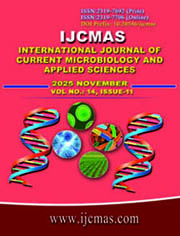


 National Academy of Agricultural Sciences (NAAS)
National Academy of Agricultural Sciences (NAAS)

|
PRINT ISSN : 2319-7692
Online ISSN : 2319-7706 Issues : 12 per year Publisher : Excellent Publishers Email : editorijcmas@gmail.com / submit@ijcmas.com Editor-in-chief: Dr.M.Prakash Index Copernicus ICV 2018: 95.39 NAAS RATING 2020: 5.38 |
This study presents novel anionic bicelles—nanoparticles composed of DPPG and paclitaxel stabilized by cholic acid-based surfactants—prepared via a low-temperature (4°C) ultrasonic fragmentation process, yielding uniform 12-nm particles. These bicelles effectively penetrated the stratum corneum (intercellular spaces ~100 nm) and infiltrated the epidermis in vitro, demonstrating potent anti-skin cancer activity against A431, SCL I, and KB cells. In vivo, topical application significantly reduced papilloma formation in a murine skin cancer model, whereas free paclitaxel exacerbated tumor growth, confirming enhanced efficacy and targeted delivery. Concurrently, glycosylated memantine derivatives (memary-gluco-oligosaccharides) were enzymatically synthesized and exhibited superior neuroprotective effects: enhancing survival of TH? neurons in rat midbrain cultures and protecting hippocampal neurons against Aβ toxicity. In vivo, these conjugates crossed the blood-brain barrier following intraperitoneal or oral administration, increasing synaptic density in the dentate gyrus and improving spatial learning. In 6-OHDA-induced hemiparkinsonian mice, memary-gluco-oligosaccharides reduced ipsilateral rotations and restored contralateral hindlimb stepping, indicating marked motor symptom amelioration. Furthermore, α-tocopherol glucoside demonstrated potent anti-allergic activity against wheat allergens (gliadin/glutenin), while daidzein and glycitein glucosides effectively suppressed soybean allergen (globulin)-induced responses. Collectively, these findings establish that lipid-based nanocarriers enable transdermal drug delivery for skin cancer therapy, while enzymatic glycosylation enhances bioavailability, neuroprotection, and anti-allergic efficacy—offering promising platforms for treating neurological disorders and allergic conditions.
Ballabh, P., Braun, A. and Nedergaard, M. 2004. The blood-brain barrier: an overview: structure, regulation, and clinical implications. Neur. Dis. 16:1-13. https://doi.org/10.1016/j.nbd.2003.12.016
Berardi, V., Ricci, F., Castelli, M., Galati, G. and Risuleo, G. 2009. Resveratrol exhibits a strong cytotoxic activity in cultured cells and has an antiviral action against polyomavirus: potential clinical use. J. Exper. Clin. Cancer Res. 28:96. https://doi.org/10.1186/1756-9966-28-96
Daneman, R. and Prat, A. 2015. The blood-brain barrier. Cold Spr. Harb Persp. Biol. 7:1-23. https://doi.org/10.1101/cshperspect.a020412
Evers, D., Wang, X., Huong, S.-M., Huang, D.Y. and Huang, E.-S. 2004. 3,4',5-Trihydroxy-trans-stilbene (resveratrol) inhibits human cytomegalovirus replication and virus-induced cellular signaling. Antiv. Res. 63:85-95. https://doi.org/10.1016/j.antiviral.2004.03.002
Gelmon, K. 1994. The taxoids: paclitaxel and docetaxel. Lancet. 344:1267-1272. https://doi.org/10.1016/s0140-6736(94)90754-4
Gynther, M., Ropponen, J., Laine, K., Leppanen, J., Haapakoski, P., Peura, L., Jarvinen, T. and Rautio, J. 2009. Glucose promoiety enables glucose transporter mediated brain uptake of ketoprofen and indomethacin prodrugs in rats. J. Med. Chem. 52:3348-3353. https://doi.org/10.1021/jm8015409
Hashemi, M., Roohi-Azizi, M., Hashemi, F. 2022. Anti-apoptotic effect of memantine in a rat hippocampal cell model of Alzheimer's disease: morphology and cellular mechanism. Res. Square 3703:1-21.https://doi.org/10.21203/rs.3.rs-1693554/v1
Minkeviciene, R., Banerjee, P., Tanila, H. 2004. Memantine improves spatial learning in a transgenic mouse model of Alzheimer's disease. J. Pharm. Exp. Therap. 311:677-682. https://doi.org/org/10.1124/jpet.104.071027
Narayanan, D.L., Saladi, R.N. and Fox, J.L. 2010. Review: ultraviolet radiation and skin cancer. Int J Dermatol. 49:978-986. https://doi.org/10.1111/j.1365-4632.2010.04474.x.
Niles, R.M., Cook, C.P., Meadows, G.G., Fu, Y.M., McLaughlin, J.L. and Rankin, G.O. 2006. Resveratrol is rapidly metabolized in athymic (nu/nu) mice and does not inhibit human melanoma xenograft tumor growth. J. Nutr. 136: 2542-2548. https://doi.org/10.1093/jn/136.10.2542
Perez, E.A. 2009. Microtubule inhibitors: differentiating tubulin-inhibiting agents based on mechanisms of action, clinical activity, and resistance. Mol. Cancer Ther. 8:2086-2095. https://doi.org/10.1158/1535-7163.MCT-09-0366
Shan, Z., Yang, G., Xiang, W., Pei?jun, W. and Bin, Z. 2014. Effects of resveratrol on oral squamous cell carcinoma (OSCC) cells In vitro. J. Cancer Res. Clin. Oncol. 140:371-374. https://doi.org/10.1007/s00432-013-1575-1
Uchida, N., Shimoda, K. and Hamada, H. 2022. Dispersion of cannabidiol into small-sized nanoparticles using Technol PG. 17:1-3. https://doi.org/10.1177/1934578X221130864
Uchida, N., Yanagi, M. and Hamada, H. 2020. Size-tunable paclitaxel nanoparticles stabilized by anionic phospholipids for transdermal delivery applications. 15:1-4. https://doi.org/10.1177/1934578X19900684
Wu, H.-M., Tzeng, N-S., Qian, L., et al. 2009. Novel neuroprotective mechanisms of memantine: increase in neurotrophic factor release from astroglia and anti-inflammation by preventing microglial over-activation. Neuro-psychopharmacology. 34: 2344-2357. https://doi.org/10.1038/npp.2009.64
Zhu, L. and Chen, L. 2019. Progress in research on paclitaxel and tumor immunotherapy. Cellular & Molecular Biology Letters 24:1-11. https://doi.org/10.1186/s11658-019-0164-y |
 |
 |
 |
 |